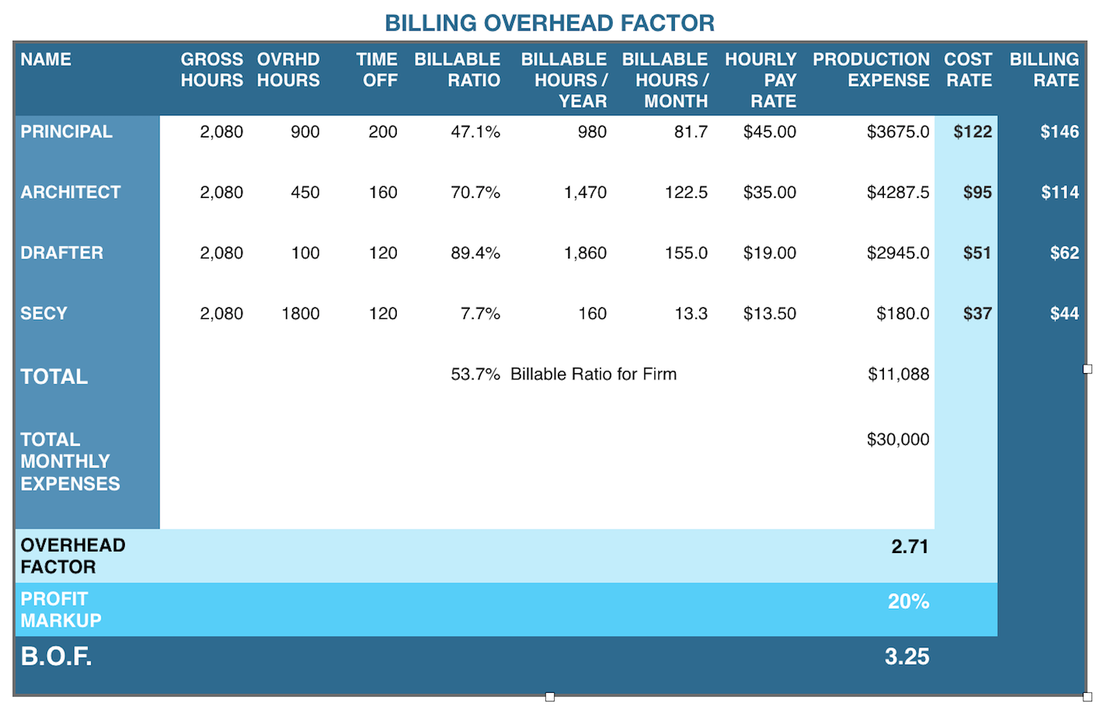|
Determining your Billing Overhead Factor [BOF] can be an eye-opening exercise. I learned this technique from Paige Highfill, an architect, who was teaching other architects how computers can be used in architecture even before CAD came along. When I tried out the calculation, I was shocked to find that we were losing $15 per hour on every hour we billed! I suggest that you avoid that situation. Your BOF is the multiplier that you must apply to the cost of every hour that you bill in order to include your overhead costs and your profit. This is the formula for determining your BOF: (TOTAL MONTHLY EXPENSE / TOTAL MONTHLY PRODUCTION EXPENSE) X PROFIT MARKUP. And here is how you calculate it.
TOTAL MONTHLY EXPENSE First total your yearly business expenses. This is EVERYTHING except design consultants. This includes business consultants, wages, payroll expenses, everything that you spend money on because you have a business. Now divide by 12 to get your average monthly total expenses. TOTAL MONTHLY PRODUCTION EXPENSE Next you will calculate how much you spend on the labor to produce the work that you are able to bill for. You will do this for each individual in your firm (or just yourself if you are a solo act). Gather these pieces of information:
Once you have your data, you perform this calculation for each person: (((gross annual hours - annual Time Off hours - annual overhead hours) / gross annual hours) / 12) x Hourly Pay Rate = individual's Production Expense per month. The total of all the individuals equals the Total Monthly Production Expense. The next step is to find your OVERHEAD FACTOR. You find the Overhead Factor by dividing the TOTAL MONTHLY EXPENSE by the TOTAL MONTHLY PRODUCTION EXPENSE. This number represents your OVERHEAD FACTOR. This number is usually more than 2.0 and less than 5.0. If you are far outside this range, check your calculations. It is more desirable to be low than high. Low means your overhead is low. A high overhead means you may have trouble being competitive because your business is inherently inefficient. However, we aren't finished just yet - you need to find the BILLING OVERHEAD FACTOR. The Overhead Factor tells you how much you have to charge just to break even. Usually this is used as a 'Charge Rate' by multiplying this factor times the individual’s HOURLY Pay Rate and 'charging' it to the project. (NOTE: the spreadsheet shows the Charge Rate as the Cost Rate.) What is missing is Profit! There are a lot of ways to look at profit. You can use an arbitrary percent. You can pick an amount and determine what percent that is of your TOTAL MONTHLY EXPENSE. You have to decide this for yourself. The profit markup is usually in the range of 10% to 25%; but you might have reasons to go outside the range. It's your call. In any event you write the percent profit markup that you have chosen as a decimal, add 1.0 and multiply times your Overhead Factor to get your BILLING OVERHEAD FACTOR. For example, if your Overhead Factor is 3.1 and your desired profit markup is 20%, then you calculate 3.1 x 1.2 = 3.72 to get your Billing Overhead Factor. To get each person's Billing Rate, Multiply your Billing Overhead Factor times each person’s Hourly Pay Rate. I suggest that you make a simple spreadsheet like the example above, save it, and review/update it once or twice a year. Or you can download and customize the one above. Once you are armed with this information about your Billing Overhead Factor, you can monitor your Billing Ratio in your bookkeeping system. Comments are closed.
|
x
Archives
February 2024
Categories
All
|
Architekwiki | Architect's Resource | Greater Cincinnati
© 2012-2022 Architekwiki
© 2012-2022 Architekwiki








